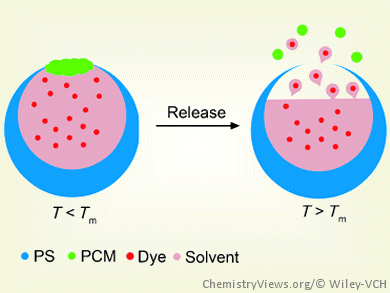Uncorking the Potential of “Intelligent” Drug-Delivery Systems
Sustained-release formulations that release drugs over longer periods of time are not the final step in the evolution of “intelligent” drug-delivery systems. Modern pharmaceuticals are being designed to be released only in a specific, diseased organ; on cues from our circadian rhythm; or under specific physiological conditions. In the journal Angewandte Chemie, a team of American and Korean researchers has now introduced “microbottles” with “corks” that release their contents only when the temperature rises above a defined level.
Our circadian rhythms can cause our reaction to a drug to vary with time. Certain conditions and symptoms can also fluctuate with our circadian rhythm. Some pharmaceuticals, such as beta blockers, chemotherapy drugs, and cortisone treatments thus come with recommendations for timing doses. The “intelligent” control drug release based on changing physiological conditions is an extension of these ideas
Temperature in particular could be a useful regulator for such systems. Our body temperature varies throughout the day and in response to certain physiological states or phases, like disease. An “intelligent” blood pressure reducing drug could be released when body temperature and blood pressure rise due to stress. Inflammation usually causes the temperature of the affected area to rise, so a drug could be directed only to these hot areas. Alternatively, a diseased area of the body, such as a tumor, could be locally warmed to release chemotherapy drugs on the spot, causing fewer side effects.
Drug Release Controlled by Temperature
Previous types of temperature-controlled microcontainers suffered from a slow loading process, low cargo capacity, or premature release of the drug. Younan Xia and a team at the Georgia Institute of Technology, Emory University, Atlanta, USA, and Yonsei University, Seoul, Korea, have now developed a new variety of corked “microbottle” for drugs. The cork melts at a defined temperature and releases the bottle’s contents.
To produce their capsules, the researchers embedded the bottom half of some polystyrene spheres in a thin polymer film and soaked them with a mixture of toluene and water. Because toluene and water do not mix well, the toluene diffused into the spheres. The spheres were then flash-frozen and freeze-dried. The toluene evaporated, exiting trough the tops of the spheres, leaving behind an opening and a cavity. Now the little bottles can quickly and easily be filled.
To cork the bottles, the researchers applied a film of the cork material to a support and pressed it onto the support holding the vessels. Ethanol vapors cause the cork material to flow together around the vessels, hermetically sealing them. By changing the ratio of the materials used in the corks, tetradecanol and lauric acid, the melting points of the corks can be adjusted into a biologically useful range.
- Microscale Polymer Bottles Corked with a Phase-Change Material for Temperature-Controlled Release,
Dong Choon Hyun, Ping Lu, Sang-Il Choi, Unyong Jeong, Younan Xia,
Angew. Chem. Int. Ed. 2013.
DOI: 10.1002/anie.201305006




